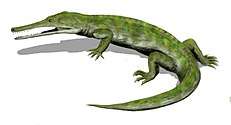Champsosaurus
Champsosaurus is an extinct genus of diapsid reptiles belonging to the order Choristodera, that existed in the Late Cretaceous and Paleogene periods. It consists of seven species: C. albertensis, C. ambulator, C. gigas, C. laramiensis, C. lindoei, C. natator, and C. tenuis.[1] The name Champsosaurus is thought to come from χαμψαι [champsai] (said in an Ancient Greek source to be an Egyptian word for "crocodiles"), and σαύρος [sauros] (Greek for "lizard"). The largest species, C. gigas, grew to 3–3.5 m (10–12 ft) in length.
| Champsosaurus | |
|---|---|
 | |
| C. natator skeleton | |
| Scientific classification | |
| Kingdom: | |
| Phylum: | |
| Class: | |
| Order: | |
| Family: | |
| Genus: | †Champsosaurus Cope, 1877 |
| Species | |
| |
| Synonyms | |
| |
Discovery
Its fossils have been found in North America (Alberta, Saskatchewan, Montana, New Mexico, Texas,[2][3] Colorado, and Wyoming) and Europe (Belgium and France), dating from the Upper Cretaceous to the mid Eocene.
Champsosaurus remains have also been found in the Hell Creek Formation, although most of these remains consist of isolated, fragmented postcranial elements.[4]
Neonate sized Champsosaurus have been documented in the scientific literature.[5]
Description


It grew to about 1.50 m (5 ft) long,[6] though C. gigas, the largest species, reached 3–3.5 m (10–12 ft) in length.[7] Champsosaurus vaguely resembled a gharial and, like gharials, it was primarily aquatic, catching fish with its long, tooth-lined jaws. It probably swam with lateral body movements, pinning its limbs against its body to increase its streamline, just like crocodiles and the marine iguana. Behind the eyes, Champsosaurus's skull was very wide, where powerful jaw muscles were attached.[8] Due to specializations in hip and limb anatomy, only females could come ashore to lay eggs, while males primarily lived in water.[9]
Anatomy
A skeleton of Champsosaurus reveals a flattened skull in the dorsoventral region, implicating adaptions to aquatic life. The skeleton featured a well-developed, intact secondary palate. Additionally, Champsosaurus is thought to have had a relatively rigid ribcage given the presence of a complete post-cranial skeleton. Internal dermal bones (gastralia) function with this ribcage to regulate the volume of the pleural cavity, effectively controlling the animal's center of gravity for underwater motion. [10]
Champsosaurus, like many of its fellow neochoristoderes, features teeth with striated enamel of the tooth crown with enamel infolding at the base. Anterior teeth are typically sharper and more slender than posterior segments.[1]
Ear bones
Endocast studies on Champsosaurus suggest that the ear bones were internal and located near the base of the skull. They are functionally most comparable to those of turtles and other aquatic reptiles, and seem more similar to those of archosauromorphs.[11]
Sexual dimorphism
Previously, two species of Champsosaurae were identified from the Tullock formation in Montana, USA. Because of their nesting behavior on land, it is believed that female champsosaurs were better adapted to terrestrial life, and this is seen in limb morphology between males and females. Sacral fusion is featured in discovered specimens, with of without deformations alike.[12] The existence of a non-deformational development of sacral fusion, coupled with the presence of more robust limb bones in some discovered individuals is thought to be a result of specific variation, in which said limbs belong to females. [13]
Metabolism
Nasal conchae have in found in neochoristoderes, suggesting that they were capable of regulating their body temperature to some extent. This is particularly relevant given the presence on Champsosaurus in the High Arctic and other cold regions.[14]
References
- Matsumoto, R., & Evans, S. E. (2016). Morphology and function of the palatal dentition in Choristodera. Journal of anatomy, 228(3), 414-429.
- Lehman, T.M., and Barnes, K., 2010, Champsosaurus (Diapsida: Choristodera) from the Paleocene of West Texas: paleoclimatic implications: Journal of Paleontology, v. 84, p. 341-345. Retrieved 20 September 2010.
- Lehman & Barnes, 2010
- Hartman, Joseph Herbert (2002). The Hell Creek Formation and the Cretaceous-Tertiary Boundary in the Northern Great Plains: An Integrated Continental Record of the End of the Cretaceous, Issue 361. p. 158.
- Tanke, D.H. and Brett-Surman, M.K. 2001. Evidence of Hatchling and Nestling-Size Hadrosaurs (Reptilia:Ornithischia) from Dinosaur Provincial Park (Dinosaur Park Formation: Campanian), Alberta, Canada. pp. 206-218. In: Mesozoic Vertebrate Life—New Research Inspired by the Paleontology of Philip J. Currie. Edited by D.H. Tanke and K. Carpenter. Indiana University Press: Bloomington. xviii + 577 pp.
- D.Lambert, D.Naish and E.Wyse 2001, "Encyclopedia of Dinosaurs and prehistoric life", p. 77, Dorling Kindersley Limited, London. ISBN 0-7513-0955-9
- https://www.dmr.nd.gov/ndfossil/poster/PDF/Champosaurus%20gigas.pdf
- Lambert et al., 2001
- Yoshihiro Katsura, Fusion of sacrals and anatomy in Champsosaurus (Diapsida, Choristodera), doi:10.1080/08912960701374659
- ERICKSON, B. R. (1985). ASPECTS OF SOME ANATOMICAL STRUCTURES OF CHAMPSOSAURUS (REPTILIA: EOSUCHIA). JOURNAL OF VERTEBRATE PALEONTOLOGY, 5(2), 111-127.
- https://curve.carleton.ca/system/files/etd/6208eb7f-08f0-42a9-9a09-6d96779836fb/etd_pdf/bf6cdd9410c74730ae7c6029e7acbc5d/dudgeon-theinternalcranialanatomyofchampsosauruslindoei.pdf
- KATSURA, Y. (2004). SEXUAL DIMORPHISM IN CHAMPSOSAURUS (DIAPSIDA, CHORISTODERA). LETHAIA, 37(3), 245-253.
- KATSURA, Y. (2007). FUSION OF SACRALS AND ANATOMY IN CHAMPSOSAURUS (DIAPSIDA, CHORISTODERA). HISTORICAL BIOLOGY, 19(3), 263-271.
- https://curve.carleton.ca/system/files/etd/6208eb7f-08f0-42a9-9a09-6d96779836fb/etd_pdf/bf6cdd9410c74730ae7c6029e7acbc5d/dudgeon-theinternalcranialanatomyofchampsosauruslindoei.pdf
